Cultural Anthropology Essay: Exploring Relativism in Chinese Culture
VerifiedAdded on 2023/05/30
|7
|2072
|395
Essay
AI Summary
This essay delves into the concept of cultural relativism by examining various aspects of Chinese culture, including traditional naming practices, marriage customs, kinship structures, and family values. It highlights the historical context of these traditions, particularly the impact of the communist party's policies on family systems and naming conventions. The essay also addresses the importance of understanding cultural differences without judgment, while acknowledging practices that may conflict with universal human rights, such as gender discrimination. It further explores the complexities of adopting certain Chinese cultural practices and emphasizes the significance of respecting cultural diversity while upholding fundamental human rights. The essay concludes by reiterating the value of cultural relativism in promoting cross-cultural understanding but also acknowledges the existence of practices that are universally considered unethical.
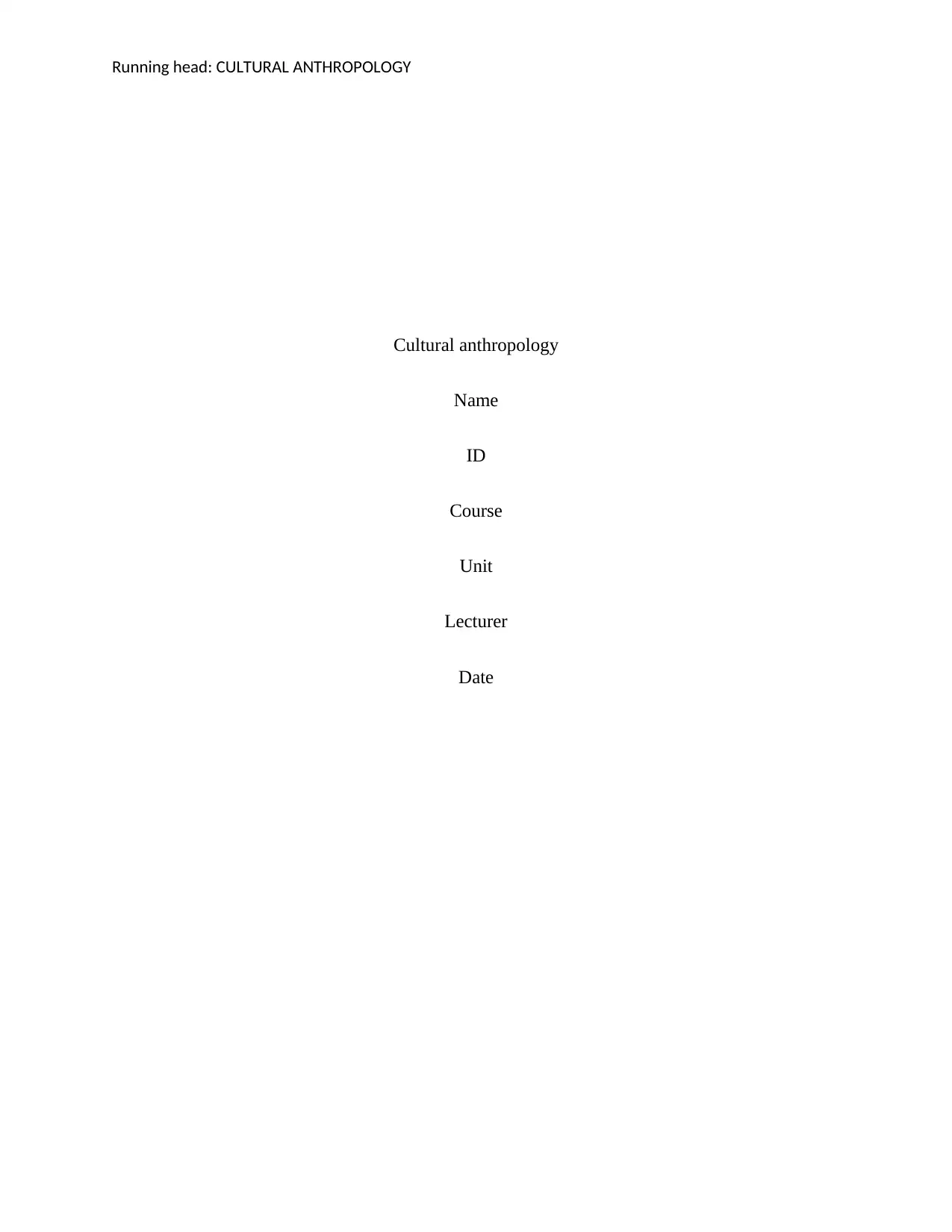
Running head: CULTURAL ANTHROPOLOGY
Cultural anthropology
Name
ID
Course
Unit
Lecturer
Date
Cultural anthropology
Name
ID
Course
Unit
Lecturer
Date
Paraphrase This Document
Need a fresh take? Get an instant paraphrase of this document with our AI Paraphraser
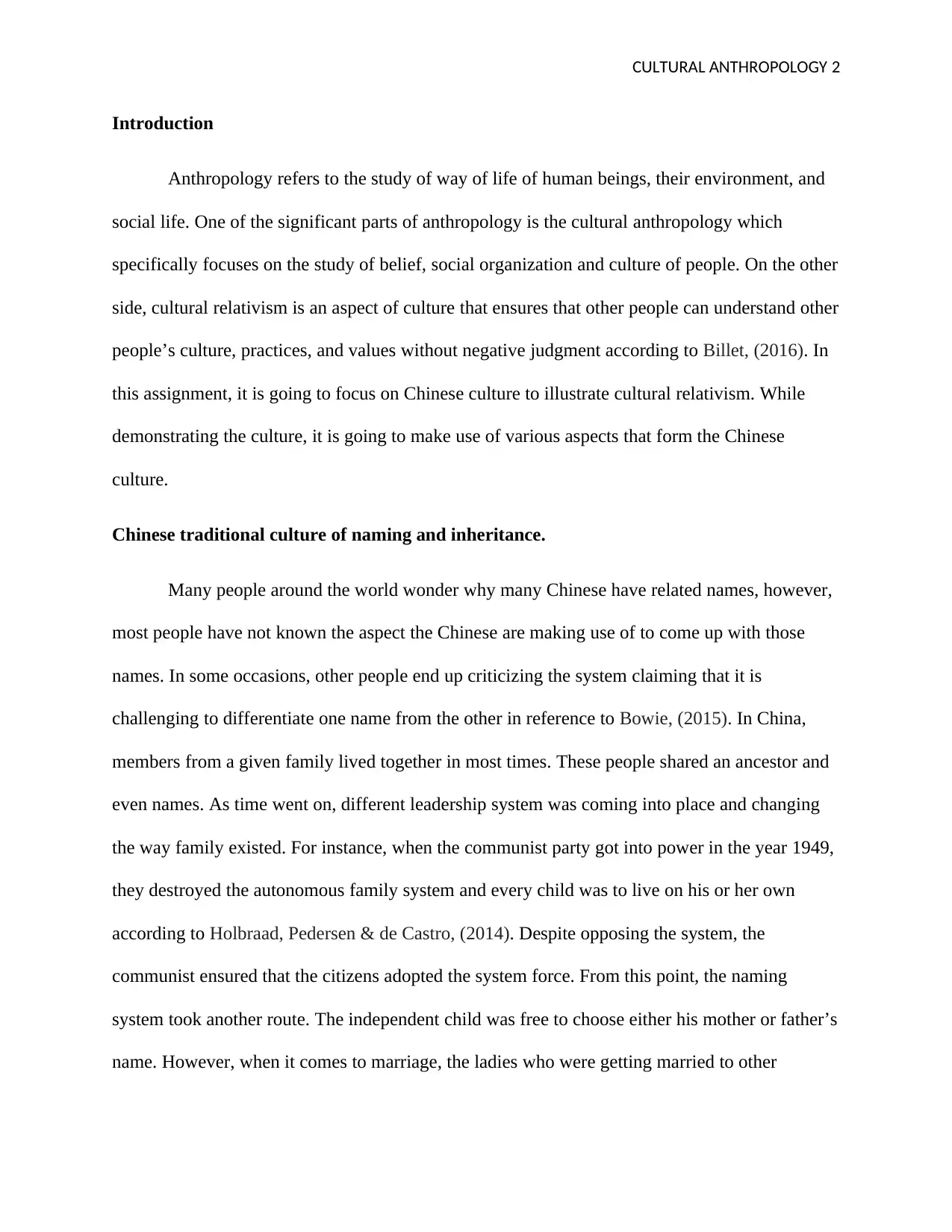
CULTURAL ANTHROPOLOGY 2
Introduction
Anthropology refers to the study of way of life of human beings, their environment, and
social life. One of the significant parts of anthropology is the cultural anthropology which
specifically focuses on the study of belief, social organization and culture of people. On the other
side, cultural relativism is an aspect of culture that ensures that other people can understand other
people’s culture, practices, and values without negative judgment according to Billet, (2016). In
this assignment, it is going to focus on Chinese culture to illustrate cultural relativism. While
demonstrating the culture, it is going to make use of various aspects that form the Chinese
culture.
Chinese traditional culture of naming and inheritance.
Many people around the world wonder why many Chinese have related names, however,
most people have not known the aspect the Chinese are making use of to come up with those
names. In some occasions, other people end up criticizing the system claiming that it is
challenging to differentiate one name from the other in reference to Bowie, (2015). In China,
members from a given family lived together in most times. These people shared an ancestor and
even names. As time went on, different leadership system was coming into place and changing
the way family existed. For instance, when the communist party got into power in the year 1949,
they destroyed the autonomous family system and every child was to live on his or her own
according to Holbraad, Pedersen & de Castro, (2014). Despite opposing the system, the
communist ensured that the citizens adopted the system force. From this point, the naming
system took another route. The independent child was free to choose either his mother or father’s
name. However, when it comes to marriage, the ladies who were getting married to other
Introduction
Anthropology refers to the study of way of life of human beings, their environment, and
social life. One of the significant parts of anthropology is the cultural anthropology which
specifically focuses on the study of belief, social organization and culture of people. On the other
side, cultural relativism is an aspect of culture that ensures that other people can understand other
people’s culture, practices, and values without negative judgment according to Billet, (2016). In
this assignment, it is going to focus on Chinese culture to illustrate cultural relativism. While
demonstrating the culture, it is going to make use of various aspects that form the Chinese
culture.
Chinese traditional culture of naming and inheritance.
Many people around the world wonder why many Chinese have related names, however,
most people have not known the aspect the Chinese are making use of to come up with those
names. In some occasions, other people end up criticizing the system claiming that it is
challenging to differentiate one name from the other in reference to Bowie, (2015). In China,
members from a given family lived together in most times. These people shared an ancestor and
even names. As time went on, different leadership system was coming into place and changing
the way family existed. For instance, when the communist party got into power in the year 1949,
they destroyed the autonomous family system and every child was to live on his or her own
according to Holbraad, Pedersen & de Castro, (2014). Despite opposing the system, the
communist ensured that the citizens adopted the system force. From this point, the naming
system took another route. The independent child was free to choose either his mother or father’s
name. However, when it comes to marriage, the ladies who were getting married to other
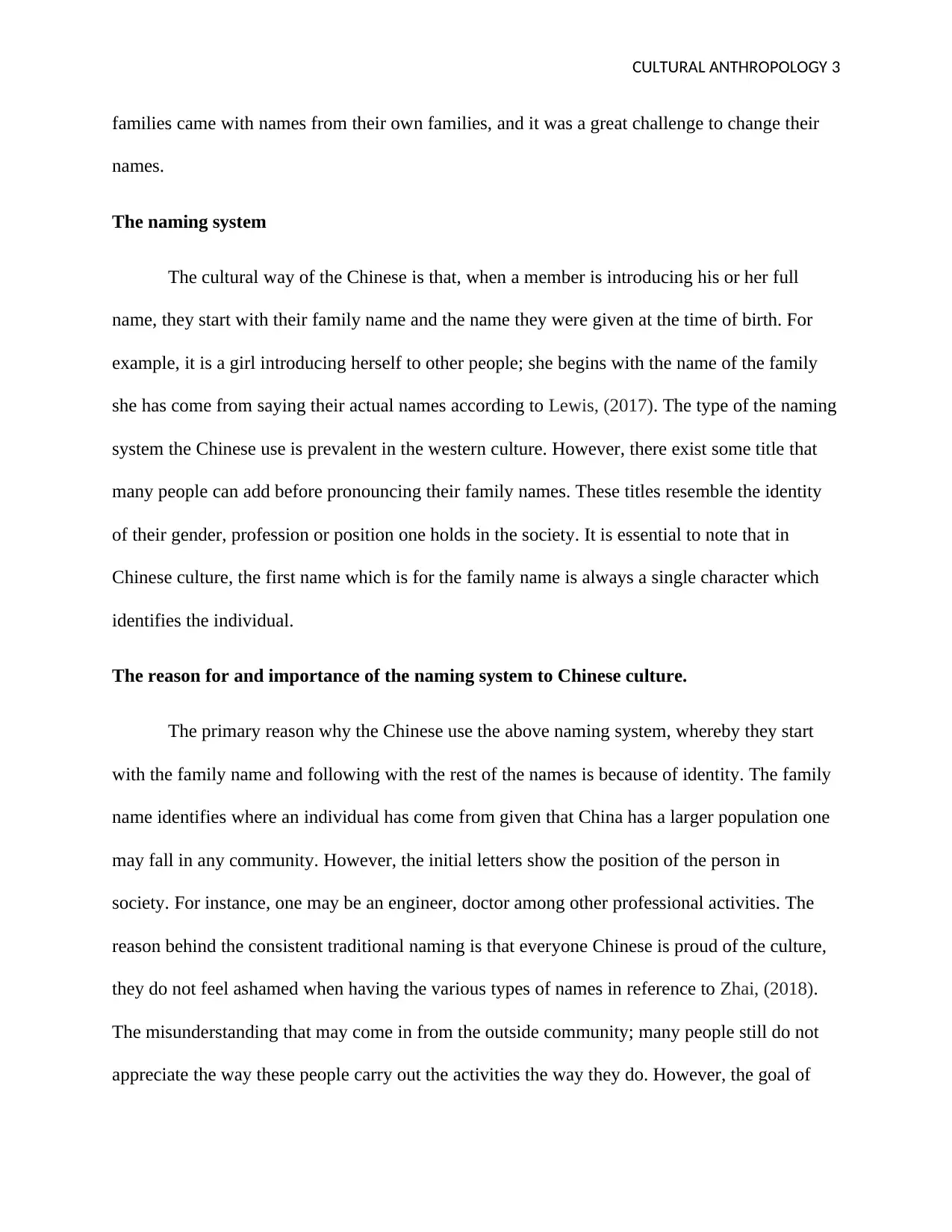
CULTURAL ANTHROPOLOGY 3
families came with names from their own families, and it was a great challenge to change their
names.
The naming system
The cultural way of the Chinese is that, when a member is introducing his or her full
name, they start with their family name and the name they were given at the time of birth. For
example, it is a girl introducing herself to other people; she begins with the name of the family
she has come from saying their actual names according to Lewis, (2017). The type of the naming
system the Chinese use is prevalent in the western culture. However, there exist some title that
many people can add before pronouncing their family names. These titles resemble the identity
of their gender, profession or position one holds in the society. It is essential to note that in
Chinese culture, the first name which is for the family name is always a single character which
identifies the individual.
The reason for and importance of the naming system to Chinese culture.
The primary reason why the Chinese use the above naming system, whereby they start
with the family name and following with the rest of the names is because of identity. The family
name identifies where an individual has come from given that China has a larger population one
may fall in any community. However, the initial letters show the position of the person in
society. For instance, one may be an engineer, doctor among other professional activities. The
reason behind the consistent traditional naming is that everyone Chinese is proud of the culture,
they do not feel ashamed when having the various types of names in reference to Zhai, (2018).
The misunderstanding that may come in from the outside community; many people still do not
appreciate the way these people carry out the activities the way they do. However, the goal of
families came with names from their own families, and it was a great challenge to change their
names.
The naming system
The cultural way of the Chinese is that, when a member is introducing his or her full
name, they start with their family name and the name they were given at the time of birth. For
example, it is a girl introducing herself to other people; she begins with the name of the family
she has come from saying their actual names according to Lewis, (2017). The type of the naming
system the Chinese use is prevalent in the western culture. However, there exist some title that
many people can add before pronouncing their family names. These titles resemble the identity
of their gender, profession or position one holds in the society. It is essential to note that in
Chinese culture, the first name which is for the family name is always a single character which
identifies the individual.
The reason for and importance of the naming system to Chinese culture.
The primary reason why the Chinese use the above naming system, whereby they start
with the family name and following with the rest of the names is because of identity. The family
name identifies where an individual has come from given that China has a larger population one
may fall in any community. However, the initial letters show the position of the person in
society. For instance, one may be an engineer, doctor among other professional activities. The
reason behind the consistent traditional naming is that everyone Chinese is proud of the culture,
they do not feel ashamed when having the various types of names in reference to Zhai, (2018).
The misunderstanding that may come in from the outside community; many people still do not
appreciate the way these people carry out the activities the way they do. However, the goal of
⊘ This is a preview!⊘
Do you want full access?
Subscribe today to unlock all pages.

Trusted by 1+ million students worldwide
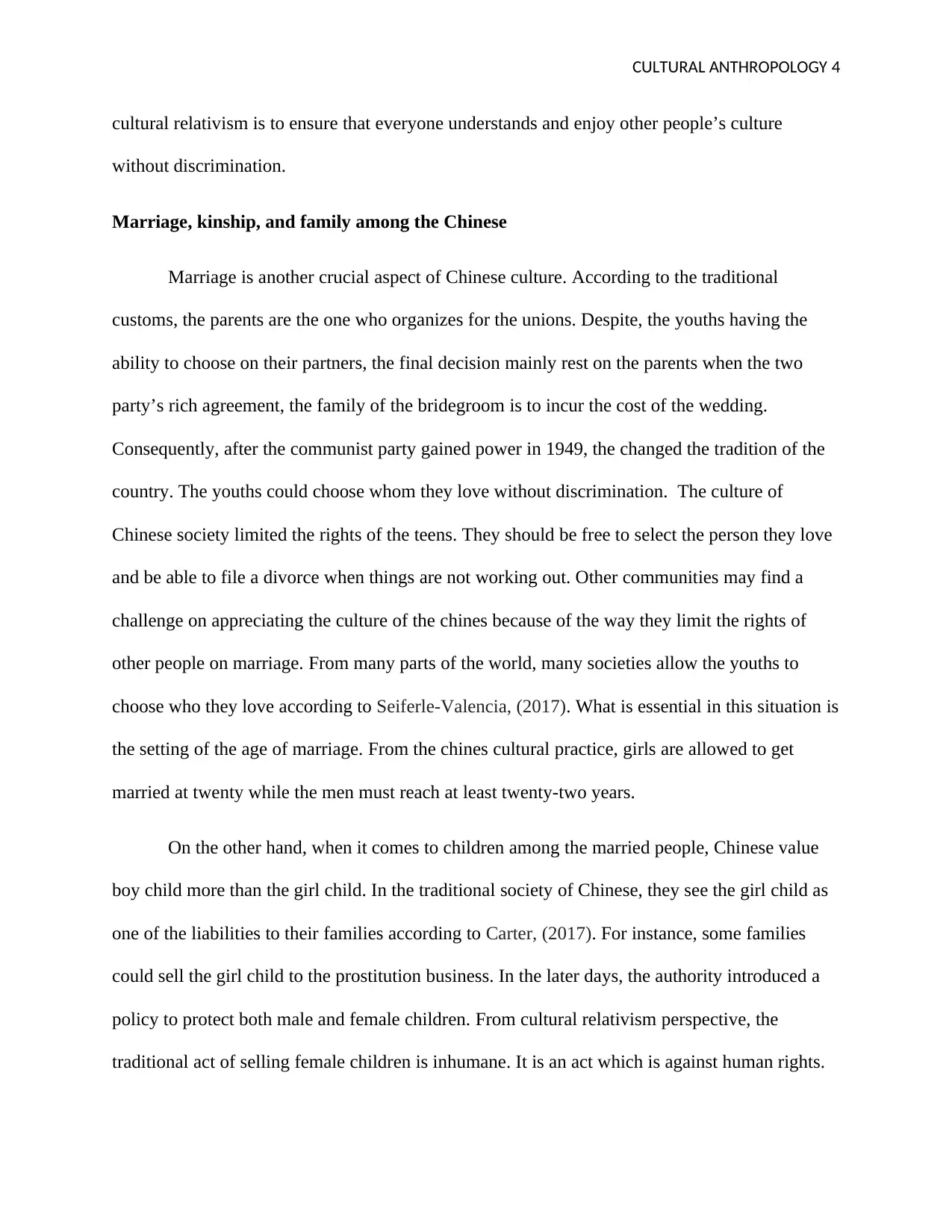
CULTURAL ANTHROPOLOGY 4
cultural relativism is to ensure that everyone understands and enjoy other people’s culture
without discrimination.
Marriage, kinship, and family among the Chinese
Marriage is another crucial aspect of Chinese culture. According to the traditional
customs, the parents are the one who organizes for the unions. Despite, the youths having the
ability to choose on their partners, the final decision mainly rest on the parents when the two
party’s rich agreement, the family of the bridegroom is to incur the cost of the wedding.
Consequently, after the communist party gained power in 1949, the changed the tradition of the
country. The youths could choose whom they love without discrimination. The culture of
Chinese society limited the rights of the teens. They should be free to select the person they love
and be able to file a divorce when things are not working out. Other communities may find a
challenge on appreciating the culture of the chines because of the way they limit the rights of
other people on marriage. From many parts of the world, many societies allow the youths to
choose who they love according to Seiferle-Valencia, (2017). What is essential in this situation is
the setting of the age of marriage. From the chines cultural practice, girls are allowed to get
married at twenty while the men must reach at least twenty-two years.
On the other hand, when it comes to children among the married people, Chinese value
boy child more than the girl child. In the traditional society of Chinese, they see the girl child as
one of the liabilities to their families according to Carter, (2017). For instance, some families
could sell the girl child to the prostitution business. In the later days, the authority introduced a
policy to protect both male and female children. From cultural relativism perspective, the
traditional act of selling female children is inhumane. It is an act which is against human rights.
cultural relativism is to ensure that everyone understands and enjoy other people’s culture
without discrimination.
Marriage, kinship, and family among the Chinese
Marriage is another crucial aspect of Chinese culture. According to the traditional
customs, the parents are the one who organizes for the unions. Despite, the youths having the
ability to choose on their partners, the final decision mainly rest on the parents when the two
party’s rich agreement, the family of the bridegroom is to incur the cost of the wedding.
Consequently, after the communist party gained power in 1949, the changed the tradition of the
country. The youths could choose whom they love without discrimination. The culture of
Chinese society limited the rights of the teens. They should be free to select the person they love
and be able to file a divorce when things are not working out. Other communities may find a
challenge on appreciating the culture of the chines because of the way they limit the rights of
other people on marriage. From many parts of the world, many societies allow the youths to
choose who they love according to Seiferle-Valencia, (2017). What is essential in this situation is
the setting of the age of marriage. From the chines cultural practice, girls are allowed to get
married at twenty while the men must reach at least twenty-two years.
On the other hand, when it comes to children among the married people, Chinese value
boy child more than the girl child. In the traditional society of Chinese, they see the girl child as
one of the liabilities to their families according to Carter, (2017). For instance, some families
could sell the girl child to the prostitution business. In the later days, the authority introduced a
policy to protect both male and female children. From cultural relativism perspective, the
traditional act of selling female children is inhumane. It is an act which is against human rights.
Paraphrase This Document
Need a fresh take? Get an instant paraphrase of this document with our AI Paraphraser
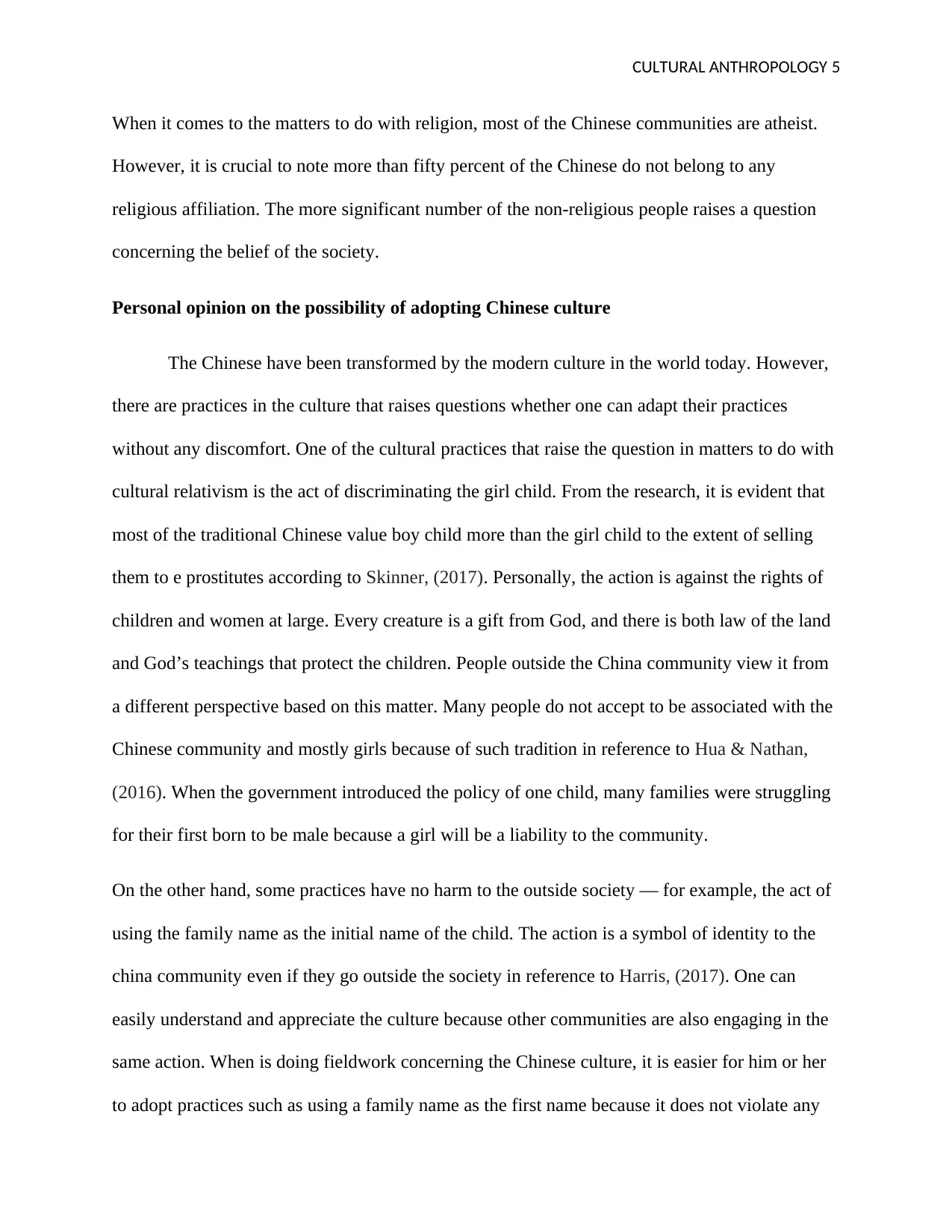
CULTURAL ANTHROPOLOGY 5
When it comes to the matters to do with religion, most of the Chinese communities are atheist.
However, it is crucial to note more than fifty percent of the Chinese do not belong to any
religious affiliation. The more significant number of the non-religious people raises a question
concerning the belief of the society.
Personal opinion on the possibility of adopting Chinese culture
The Chinese have been transformed by the modern culture in the world today. However,
there are practices in the culture that raises questions whether one can adapt their practices
without any discomfort. One of the cultural practices that raise the question in matters to do with
cultural relativism is the act of discriminating the girl child. From the research, it is evident that
most of the traditional Chinese value boy child more than the girl child to the extent of selling
them to e prostitutes according to Skinner, (2017). Personally, the action is against the rights of
children and women at large. Every creature is a gift from God, and there is both law of the land
and God’s teachings that protect the children. People outside the China community view it from
a different perspective based on this matter. Many people do not accept to be associated with the
Chinese community and mostly girls because of such tradition in reference to Hua & Nathan,
(2016). When the government introduced the policy of one child, many families were struggling
for their first born to be male because a girl will be a liability to the community.
On the other hand, some practices have no harm to the outside society — for example, the act of
using the family name as the initial name of the child. The action is a symbol of identity to the
china community even if they go outside the society in reference to Harris, (2017). One can
easily understand and appreciate the culture because other communities are also engaging in the
same action. When is doing fieldwork concerning the Chinese culture, it is easier for him or her
to adopt practices such as using a family name as the first name because it does not violate any
When it comes to the matters to do with religion, most of the Chinese communities are atheist.
However, it is crucial to note more than fifty percent of the Chinese do not belong to any
religious affiliation. The more significant number of the non-religious people raises a question
concerning the belief of the society.
Personal opinion on the possibility of adopting Chinese culture
The Chinese have been transformed by the modern culture in the world today. However,
there are practices in the culture that raises questions whether one can adapt their practices
without any discomfort. One of the cultural practices that raise the question in matters to do with
cultural relativism is the act of discriminating the girl child. From the research, it is evident that
most of the traditional Chinese value boy child more than the girl child to the extent of selling
them to e prostitutes according to Skinner, (2017). Personally, the action is against the rights of
children and women at large. Every creature is a gift from God, and there is both law of the land
and God’s teachings that protect the children. People outside the China community view it from
a different perspective based on this matter. Many people do not accept to be associated with the
Chinese community and mostly girls because of such tradition in reference to Hua & Nathan,
(2016). When the government introduced the policy of one child, many families were struggling
for their first born to be male because a girl will be a liability to the community.
On the other hand, some practices have no harm to the outside society — for example, the act of
using the family name as the initial name of the child. The action is a symbol of identity to the
china community even if they go outside the society in reference to Harris, (2017). One can
easily understand and appreciate the culture because other communities are also engaging in the
same action. When is doing fieldwork concerning the Chinese culture, it is easier for him or her
to adopt practices such as using a family name as the first name because it does not violate any
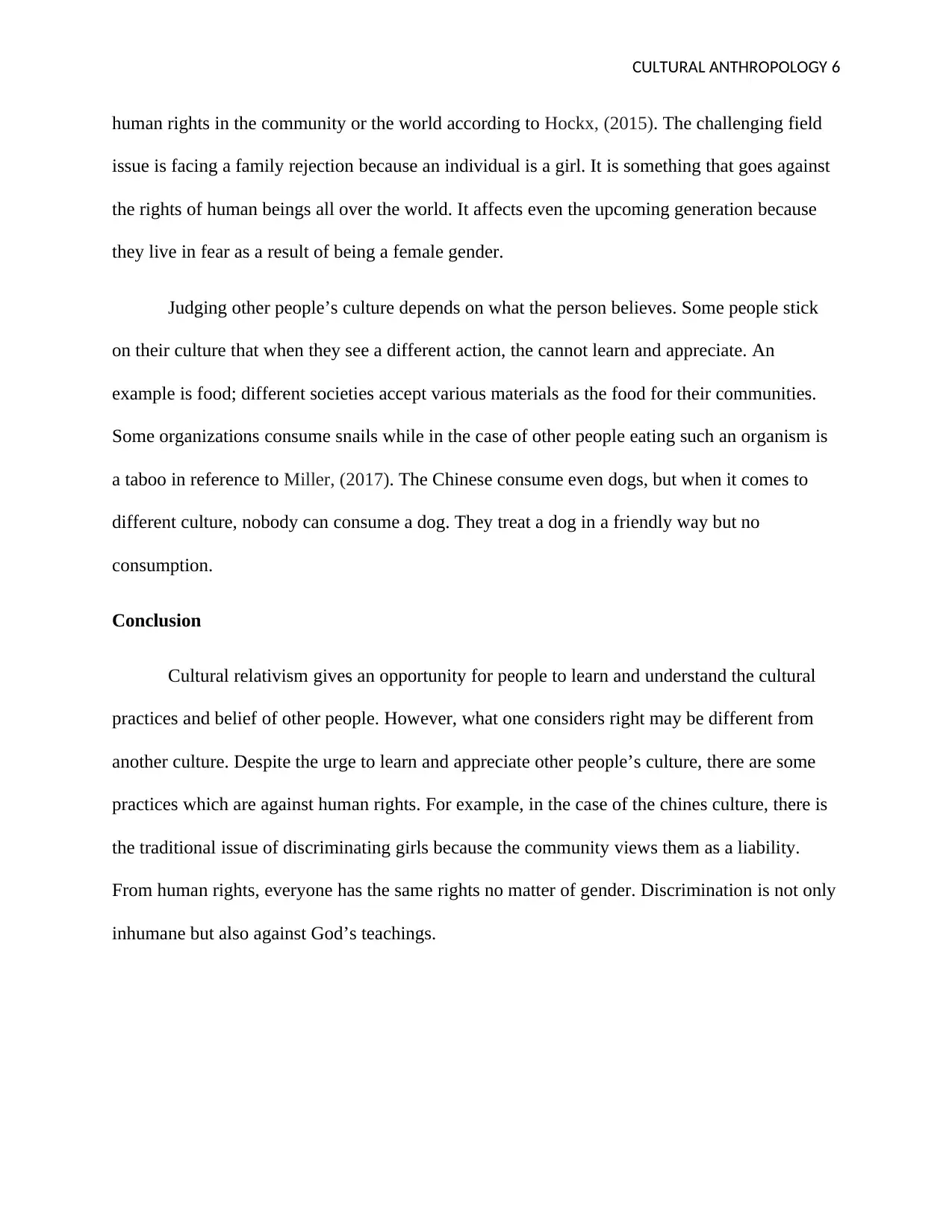
CULTURAL ANTHROPOLOGY 6
human rights in the community or the world according to Hockx, (2015). The challenging field
issue is facing a family rejection because an individual is a girl. It is something that goes against
the rights of human beings all over the world. It affects even the upcoming generation because
they live in fear as a result of being a female gender.
Judging other people’s culture depends on what the person believes. Some people stick
on their culture that when they see a different action, the cannot learn and appreciate. An
example is food; different societies accept various materials as the food for their communities.
Some organizations consume snails while in the case of other people eating such an organism is
a taboo in reference to Miller, (2017). The Chinese consume even dogs, but when it comes to
different culture, nobody can consume a dog. They treat a dog in a friendly way but no
consumption.
Conclusion
Cultural relativism gives an opportunity for people to learn and understand the cultural
practices and belief of other people. However, what one considers right may be different from
another culture. Despite the urge to learn and appreciate other people’s culture, there are some
practices which are against human rights. For example, in the case of the chines culture, there is
the traditional issue of discriminating girls because the community views them as a liability.
From human rights, everyone has the same rights no matter of gender. Discrimination is not only
inhumane but also against God’s teachings.
human rights in the community or the world according to Hockx, (2015). The challenging field
issue is facing a family rejection because an individual is a girl. It is something that goes against
the rights of human beings all over the world. It affects even the upcoming generation because
they live in fear as a result of being a female gender.
Judging other people’s culture depends on what the person believes. Some people stick
on their culture that when they see a different action, the cannot learn and appreciate. An
example is food; different societies accept various materials as the food for their communities.
Some organizations consume snails while in the case of other people eating such an organism is
a taboo in reference to Miller, (2017). The Chinese consume even dogs, but when it comes to
different culture, nobody can consume a dog. They treat a dog in a friendly way but no
consumption.
Conclusion
Cultural relativism gives an opportunity for people to learn and understand the cultural
practices and belief of other people. However, what one considers right may be different from
another culture. Despite the urge to learn and appreciate other people’s culture, there are some
practices which are against human rights. For example, in the case of the chines culture, there is
the traditional issue of discriminating girls because the community views them as a liability.
From human rights, everyone has the same rights no matter of gender. Discrimination is not only
inhumane but also against God’s teachings.
⊘ This is a preview!⊘
Do you want full access?
Subscribe today to unlock all pages.

Trusted by 1+ million students worldwide
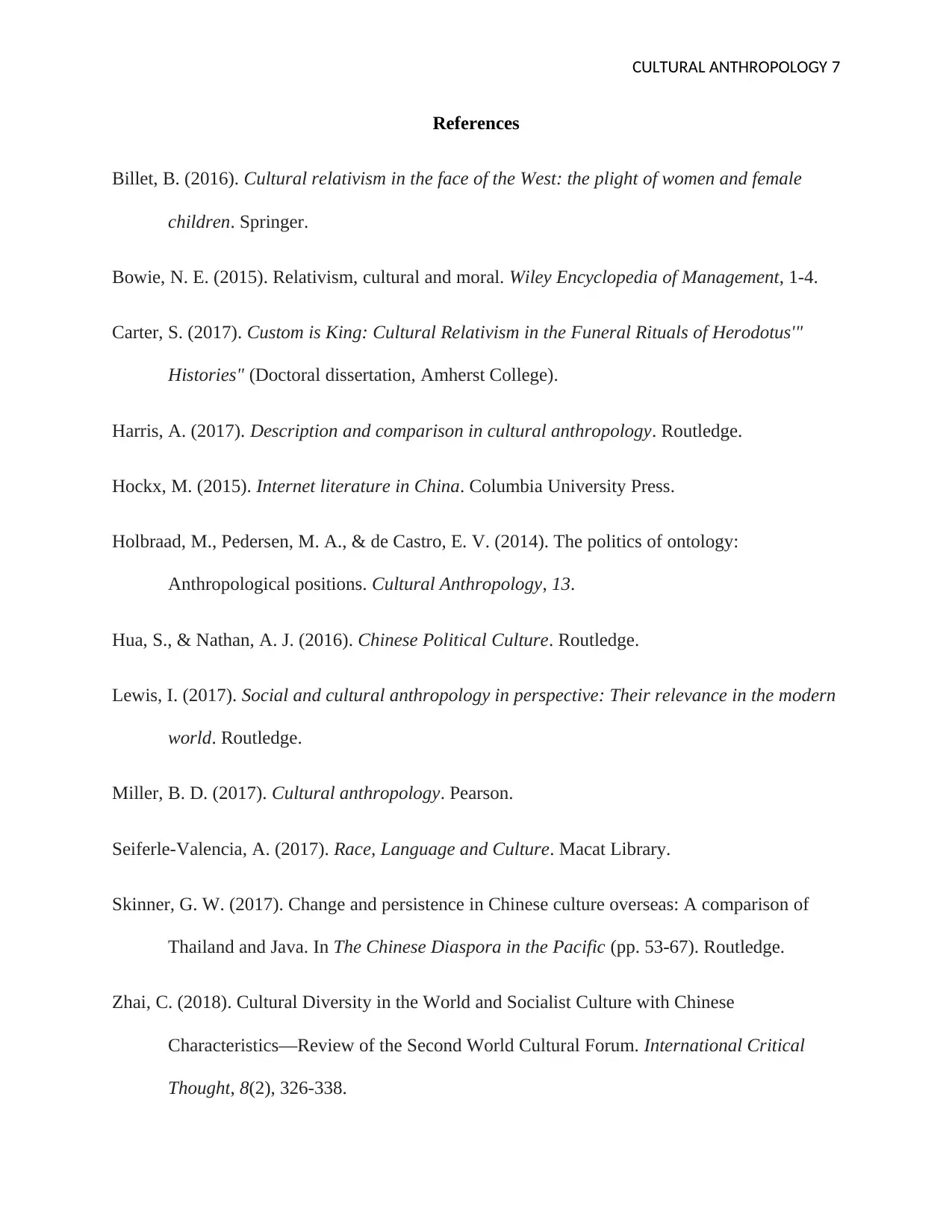
CULTURAL ANTHROPOLOGY 7
References
Billet, B. (2016). Cultural relativism in the face of the West: the plight of women and female
children. Springer.
Bowie, N. E. (2015). Relativism, cultural and moral. Wiley Encyclopedia of Management, 1-4.
Carter, S. (2017). Custom is King: Cultural Relativism in the Funeral Rituals of Herodotus'"
Histories" (Doctoral dissertation, Amherst College).
Harris, A. (2017). Description and comparison in cultural anthropology. Routledge.
Hockx, M. (2015). Internet literature in China. Columbia University Press.
Holbraad, M., Pedersen, M. A., & de Castro, E. V. (2014). The politics of ontology:
Anthropological positions. Cultural Anthropology, 13.
Hua, S., & Nathan, A. J. (2016). Chinese Political Culture. Routledge.
Lewis, I. (2017). Social and cultural anthropology in perspective: Their relevance in the modern
world. Routledge.
Miller, B. D. (2017). Cultural anthropology. Pearson.
Seiferle-Valencia, A. (2017). Race, Language and Culture. Macat Library.
Skinner, G. W. (2017). Change and persistence in Chinese culture overseas: A comparison of
Thailand and Java. In The Chinese Diaspora in the Pacific (pp. 53-67). Routledge.
Zhai, C. (2018). Cultural Diversity in the World and Socialist Culture with Chinese
Characteristics—Review of the Second World Cultural Forum. International Critical
Thought, 8(2), 326-338.
References
Billet, B. (2016). Cultural relativism in the face of the West: the plight of women and female
children. Springer.
Bowie, N. E. (2015). Relativism, cultural and moral. Wiley Encyclopedia of Management, 1-4.
Carter, S. (2017). Custom is King: Cultural Relativism in the Funeral Rituals of Herodotus'"
Histories" (Doctoral dissertation, Amherst College).
Harris, A. (2017). Description and comparison in cultural anthropology. Routledge.
Hockx, M. (2015). Internet literature in China. Columbia University Press.
Holbraad, M., Pedersen, M. A., & de Castro, E. V. (2014). The politics of ontology:
Anthropological positions. Cultural Anthropology, 13.
Hua, S., & Nathan, A. J. (2016). Chinese Political Culture. Routledge.
Lewis, I. (2017). Social and cultural anthropology in perspective: Their relevance in the modern
world. Routledge.
Miller, B. D. (2017). Cultural anthropology. Pearson.
Seiferle-Valencia, A. (2017). Race, Language and Culture. Macat Library.
Skinner, G. W. (2017). Change and persistence in Chinese culture overseas: A comparison of
Thailand and Java. In The Chinese Diaspora in the Pacific (pp. 53-67). Routledge.
Zhai, C. (2018). Cultural Diversity in the World and Socialist Culture with Chinese
Characteristics—Review of the Second World Cultural Forum. International Critical
Thought, 8(2), 326-338.
1 out of 7
Related Documents
Your All-in-One AI-Powered Toolkit for Academic Success.
+13062052269
info@desklib.com
Available 24*7 on WhatsApp / Email
![[object Object]](/_next/static/media/star-bottom.7253800d.svg)
Unlock your academic potential
Copyright © 2020–2026 A2Z Services. All Rights Reserved. Developed and managed by ZUCOL.





